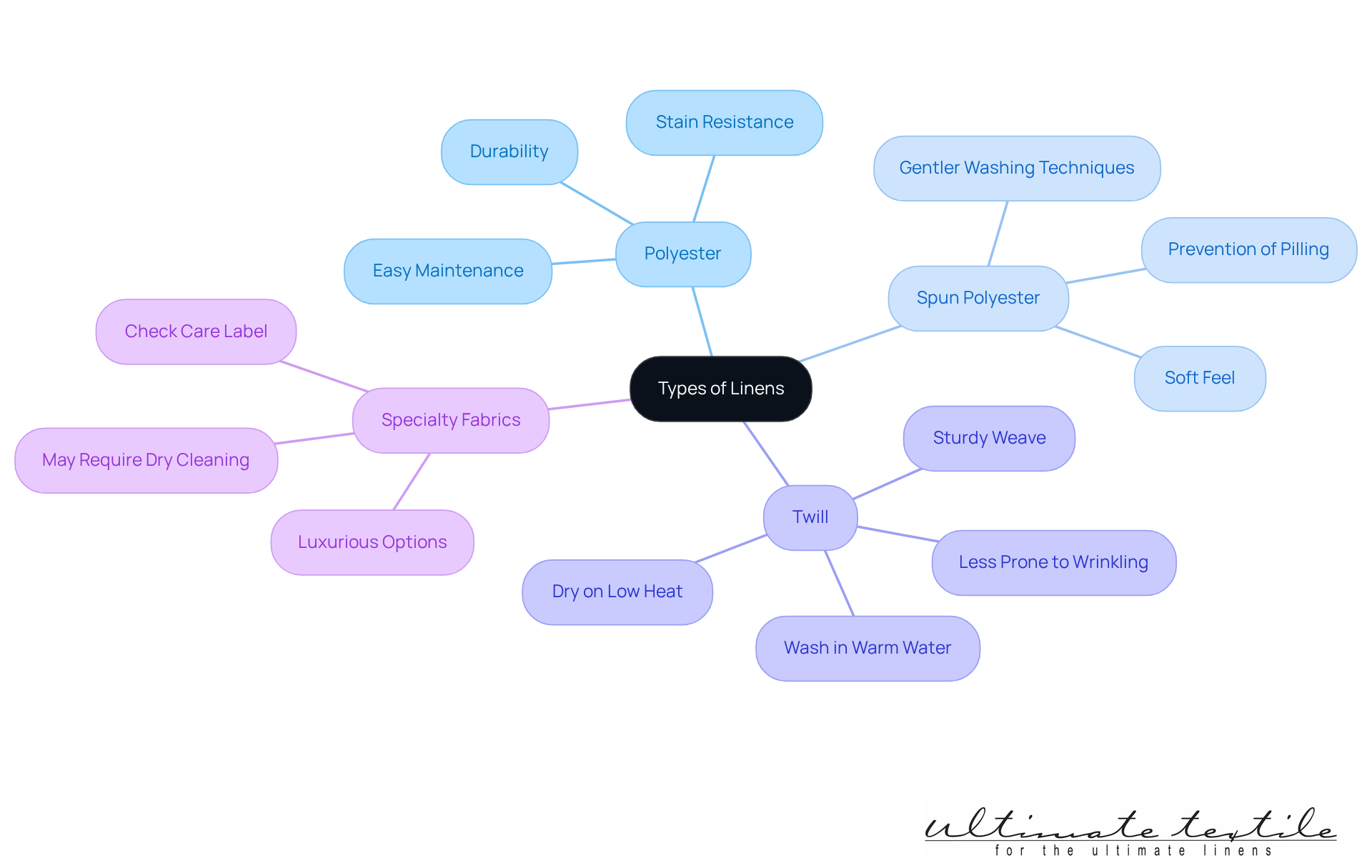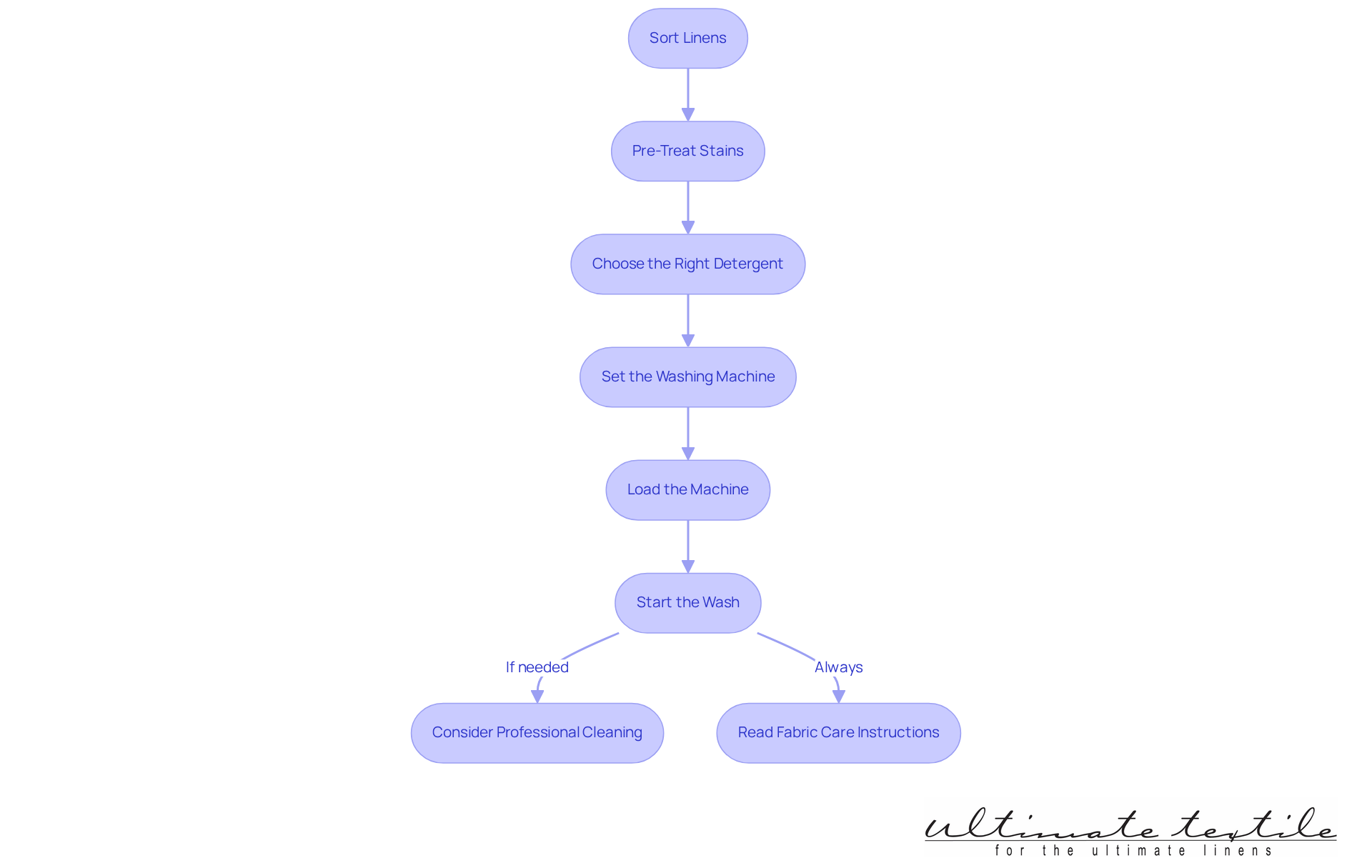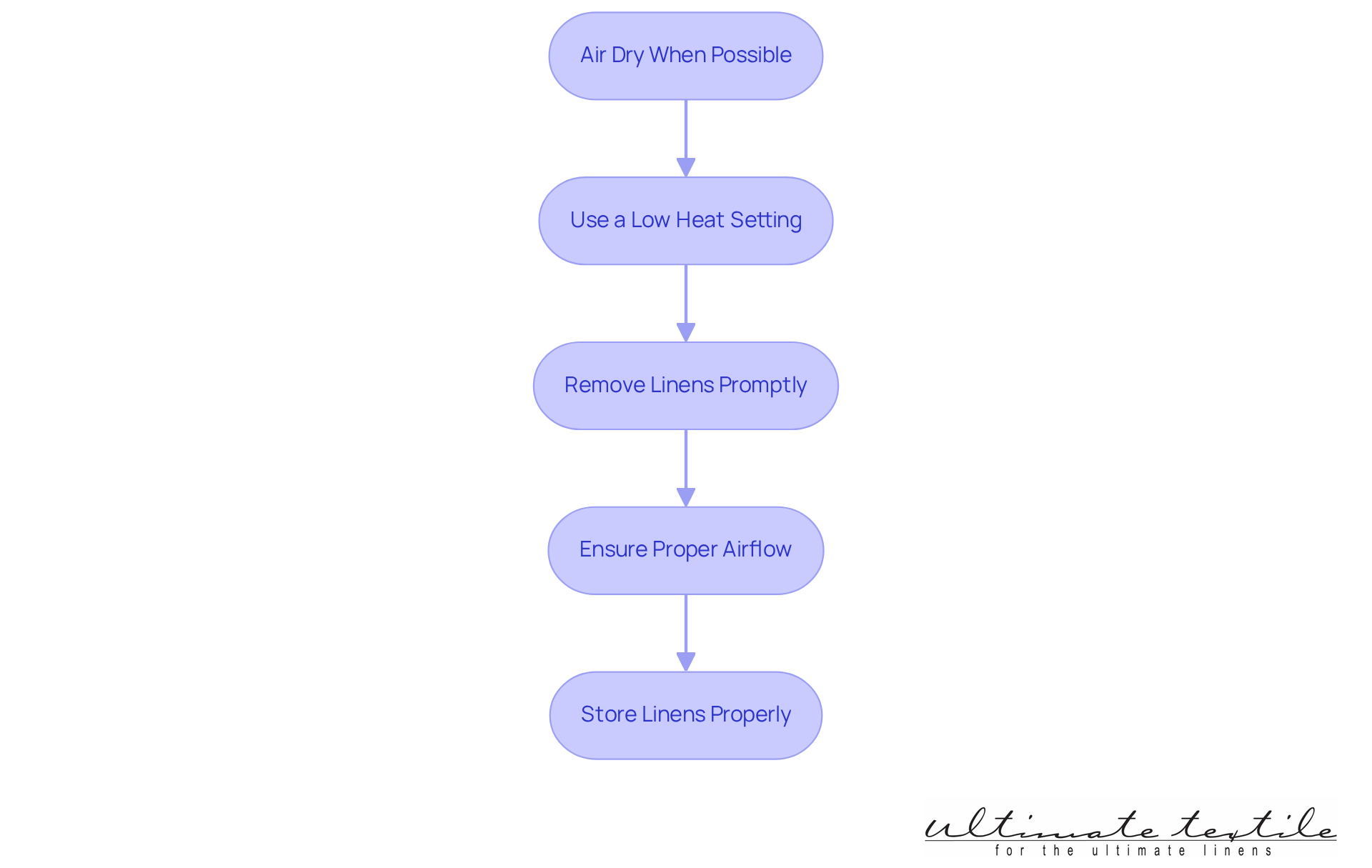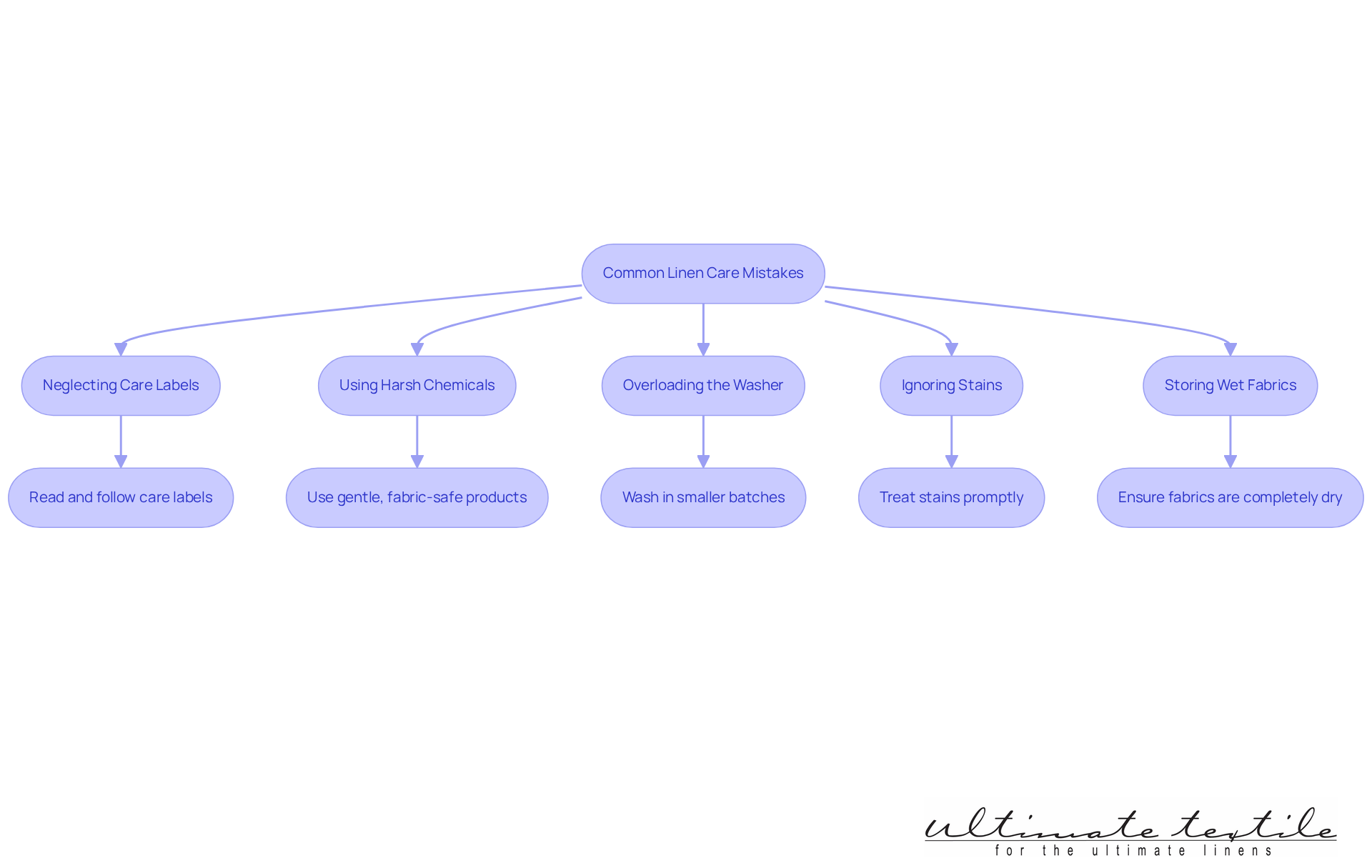Overview
This article is here to support event planners in caring for linens, addressing the challenges you may face in maintaining quality textiles. Understanding the different types of fabrics, proper washing techniques, and the best drying practices is crucial.
Have you ever faced last-minute changes that left you scrambling? By following the detailed guidance provided, you can avoid common mistakes and ensure your linens remain in excellent condition. This not only preserves their quality and longevity but also enhances the overall presentation of your events.
Together, we can create beautiful events that leave a lasting impression.
Introduction
Understanding the intricacies of linen care can feel overwhelming, especially for event planners striving to create stunning and memorable occasions. With a variety of fabric types—from durable polyester to luxurious velvet—each demands specific cleaning and maintenance techniques to ensure longevity and pristine appearance.
Have you ever faced the challenge of managing these textiles without compromising their quality? You're not alone. Many planners struggle with the complexities of proper linen care.
This guide delves into essential steps that not only simplify the process but also empower you to maintain your linens in impeccable condition for every event. Together, we can ensure your linens shine beautifully, making your events unforgettable.
Understand Your Linens: Types and Care Requirements
To effectively care for your linens, it's essential to understand the various types of linens available, as this knowledge can alleviate concerns about maintenance and longevity. Have you ever felt overwhelmed by the choices? Let’s break it down together:
- Polyester: Durable and stain-resistant, polyester linens are a breeze to clean and maintain. They can withstand frequent washing without losing their shape or color, making them a reliable choice for any event.
- Spun Polyester: Offering a softer feel while retaining the durability of polyester, spun polyester requires similar care. However, it’s wise to use gentler washing techniques to prevent pilling, ensuring your linens stay in great condition.
- Twill: Known for its diagonal weave, twill is sturdy and less prone to wrinkling. It can be washed in warm water, but remember to dry it on low heat to maintain its quality.
- Specialty Fabrics (e.g., Velvet, Satin): These luxurious options require a bit more tender care. Always check the care label, as some may necessitate dry cleaning to keep them looking their best.
Grasping these distinctions will empower you to select the appropriate cleaning techniques and items for each fabric type. Together, we can ensure your linens remain in superb condition for every occasion, allowing you to concentrate on creating beautiful events.

Wash Linens Correctly: Techniques and Detergents
To wash your linens effectively, let’s explore some essential steps together:
- Sort Linens: Begin by separating linens by color and fabric type. This simple act prevents color bleeding and damage to linens, ensuring your whites and colors remain vibrant and beautiful.
- Pre-Treat Stains: Have you ever noticed a stubborn stain? For visible marks, apply a stain remover or a gentle mixture of mild detergent and water directly to the affected area. Allow it to sit for 10-15 minutes before washing; this enhances stain removal effectiveness and gives you peace of mind.
- Choose the Right Detergent: Opt for a mild detergent specifically formulated for delicate fabrics. It’s best to avoid bleach and fabric softeners that can harm the fibers. Recent advancements in detergent technology have introduced stain-removing enzymes that work wonders even in low temperatures. This is particularly significant because 90% of the energy consumed by a washing machine is used to heat water. Laundering in cold temperatures not only conserves energy but also protects your linens.
- Set the Washing Machine: Select a gentle cycle with cold or warm water, depending on the fabric type. Keep in mind that hot water can shrink or damage certain materials, so it’s wise to steer clear of it.
- Load the Machine: Be mindful not to overload the washing machine. Overloading can lead to inadequate cleaning and increased wear on your fabrics. Proper loading allows for better water circulation and cleaning efficiency, ensuring your linens receive the proper care they deserve.
- Start the Wash: Initiate the wash cycle and stay attentive to any unusual noises or issues, ensuring the machine operates smoothly.
- Consider Professional Cleaning: For heavily stained or delicate fabrics, don’t hesitate to seek the services of a professional cleaner. These experts possess the knowledge and specialized tools required to manage difficult stains while preserving the quality of your cherished fabrics.
- Read Fabric Care Instructions: Always check the care label on your textiles for suggested cleaning guidelines. A significant percentage of consumers (77%) frequently read these instructions, which is crucial for optimal care and maintaining the beauty of your linens.
By following these washing methods, you can effectively clean your fabrics while ensuring they stay in excellent condition for future occasions. As Brian Sansoni from the American Cleaning Institute wisely states, "It’s never been easier to do a load of laundry." Together, we can ensure your linens look their best.

Dry Linens Properly: Best Practices for Longevity
To dry your linens effectively and ensure they remain beautiful for your events, consider these best practices:
-
Air Dry When Possible: Whenever feasible, hang your fabrics to air dry. This gentle approach helps prevent shrinkage and wrinkles, extending the lifespan of your textiles. Did you know that air drying can save an average household around $170 annually? Not only that, but it significantly reduces carbon emissions, making it an eco-friendly choice. In fact, air-drying clothing can reduce climate impact by up to 67%.
-
Use a Low Heat Setting: If you must use a dryer, opt for a low heat setting to minimize damage. Elevated temperatures can lead to material shrinkage and distortion, compromising the quality of your textiles. Choosing lower temperatures helps maintain the integrity of the fibers, ensuring they remain soft and vibrant.
-
Remove your linens promptly: Once the drying cycle is complete, be sure to take your linens out immediately to prevent wrinkles. If creases do occur, consider steaming or ironing on a low setting, following the material care instructions. Prompt removal not only preserves the appearance but also reduces the need for additional treatments that can wear down the fabric over time.
-
Ensure Proper Airflow: When air drying, it's essential to ensure adequate airflow around the fabrics to facilitate effective drying and prevent musty odors. This can be achieved by spacing items appropriately and using fans or dehumidifiers if drying indoors.
-
Store your linens properly: Once dry, fold your fabrics neatly and store them in a cool, dry location. Avoid stacking heavy items on top to prevent creasing. Proper storage is crucial for preserving the quality and look of your fabrics, ensuring they are ready for your next event.
By adopting these drying methods, you can greatly improve the durability and appearance of your fabrics, ensuring they remain a lovely and practical component of your event planning toolkit. Together, we can create beautiful events while caring for our textiles.

Avoid Common Mistakes: Protect Your Linens
To protect your linens and avoid common mistakes, it's essential to keep these vital tips in mind:
- Neglecting Care Labels: Have you ever overlooked the care labels on your fabric? Always read and follow these instructions, as ignoring them can lead to irreversible damage, significantly shortening the lifespan of your textiles. Consistency in care practices is key for longevity.
- Using Harsh Chemicals: It's tempting to reach for bleach and harsh detergents, but these can weaken fibers and alter colors. Instead, choose gentle, fabric-safe cleaning products to preserve the quality of your linens.
- Overloading the Washer: Are you guilty of overloading the washing machine? This can hinder effective cleaning and contribute to wear and tear. Washing fabrics in smaller batches ensures optimal results and extends their longevity.
- Ignoring Stains: Address stains promptly! The longer a stain remains untreated, the more challenging it becomes to remove, potentially leading to permanent marks.
- Storing Wet Fabrics: Never keep fabrics while damp, as this can lead to mildew and unpleasant smells. Ensure that all fabrics are completely dry before storage to maintain their quality.
By being mindful of these common mistakes, you can ensure that your linens remain in excellent condition, ready for any event. Implementing these practices not only maintains the look and comfort of your linens but also enhances their durability, making them a valuable investment for your events. Remember, 'Quality fabric is an investment that should serve you for years, not months.' Furthermore, allowing cotton and fabric fibers to rest between uses helps preserve their structure and softness for an extended period, ensuring they stay in excellent condition for your next occasion. Lastly, consider using cold water for cleaning, as it is gentler and just as effective as hot water, which helps in further protecting your valuable linens.

Conclusion
Understanding the nuances of linen care is not just crucial; it’s a heartfelt commitment for event planners striving to maintain the beauty and longevity of their textiles. Have you ever faced the challenge of ensuring your fabrics look stunning while enduring the rigors of frequent use? By grasping the different types of linens and their specific care requirements, you empower yourself to make informed decisions that enhance the overall quality of your events.
Throughout this article, we’ve outlined essential steps for washing, drying, and protecting linens. From sorting and pre-treating stains to adopting the best drying practices and avoiding common mistakes, each section offers valuable insights that contribute to effective linen maintenance. By implementing these strategies, you can preserve your linens, ensuring they remain a reliable and beautiful component of your event toolkit.
Ultimately, caring for linens transcends mere maintenance; it represents an investment in the success of every event. By prioritizing proper linen care, you elevate your events, creating memorable experiences that leave a lasting impression. Together, let’s embrace these practices to ensure that every occasion is complemented by beautifully maintained linens, reinforcing the significance of quality and attention to detail in event planning.
Frequently Asked Questions
What are the different types of linens mentioned in the article?
The article mentions four types of linens: Polyester, Spun Polyester, Twill, and Specialty Fabrics (such as Velvet and Satin).
How should I care for polyester linens?
Polyester linens are durable and stain-resistant, making them easy to clean and maintain. They can withstand frequent washing without losing their shape or color.
What is spun polyester and how does it differ from regular polyester?
Spun polyester offers a softer feel while retaining the durability of polyester. It requires similar care, but it is recommended to use gentler washing techniques to prevent pilling.
What are the care requirements for twill linens?
Twill linens are sturdy and less prone to wrinkling. They can be washed in warm water, but it is important to dry them on low heat to maintain their quality.
How should I care for specialty fabrics like velvet and satin?
Specialty fabrics require more tender care. It is essential to check the care label, as some may need to be dry cleaned to keep them looking their best.
List of Sources
- Wash Linens Correctly: Techniques and Detergents
- How to Extend the Life of Your Event Linens | CV Linens™ (https://cvlinens.com/blogs/styling-tips/how-textend-the-life-of-event-linens?srsltid=AfmBOopEkAprSHioNCOomNB_yTUZ7i6HJO-G5DXBFxXj1ZLLsxdrIkfx)
- Laundry Practices and Water Conservation (U.S. National Park Service) (https://nps.gov/articles/laundry.htm)
- The Ultimate Guide to Cleaning Event Linens — Sydney's Suds Laundry Service (https://sydneysuds.com/all-things-laundry/the-ultimate-guide-to-cleaning-event-linens)
- Loads of Fun? Survey Finds Laundry Tops List of America’s Favorite Cleaning Tasks | The American Cleaning Institute (ACI) (https://cleaninginstitute.org/newsroom/releases/2019/loads-fun-survey-finds-laundry-tops-list-americas-favorite-cleaning-tasks)
- American Cleaning Institute 2024 National Cleaning Survey Results | The American Cleaning Institute (ACI) (https://cleaninginstitute.org/newsroom/2024/american-cleaning-institute-2024-national-cleaning-survey-results)
- Dry Linens Properly: Best Practices for Longevity
- The benefits of air-drying laundry – 5 reasons to rethink your tumble dryer this spring (https://homesandgardens.com/solved/benefits-of-air-drying-laundry)
- Stop Using the Dryer: 8 Reasons Line-Drying Your Laundry Is Better, According to Experts (https://marthastewart.com/benefits-of-line-drying-laundry-11745101)
- 7 Reasons to Choose Cloth Tablecloths Wholesale for Events (https://blog.ultimatetextile.com/7-reasons-to-choose-cloth-tablecloths-wholesale-for-events)
- Benefits of Air Drying Clothes (https://lifestyleclotheslines.com.au/blogs/news/benefits-of-air-drying-clothes?srsltid=AfmBOool5v2ku3HzJMASMeVupWxFr2xxHl5URdhqYiXyAUjeGhQn4Vm3)
- Mastering the Art of Air Drying: Your Ultimate Guide (https://tryhampr.com/how-to-air-dry-clothes-the-dos-and-donts-of-air-drying)
- Avoid Common Mistakes: Protect Your Linens
- Linen Care Mistakes Everyone Makes at Home - Let's Fix Them | Linen Hub (https://linenhub.com.au/linen-care-mistakes-everyone-makes-at-home-lets-fix-them)




